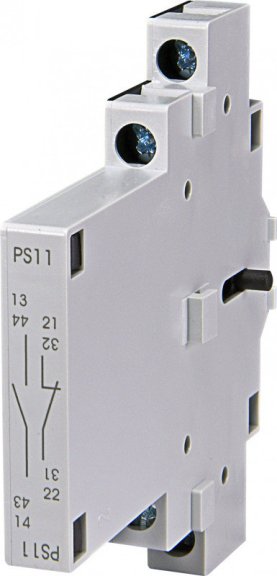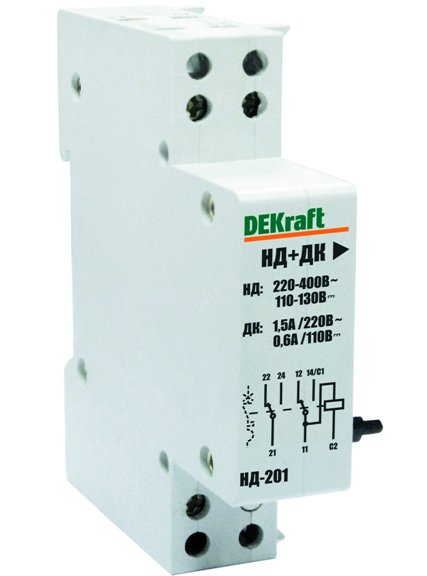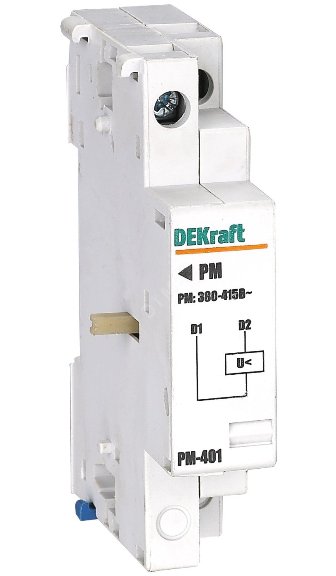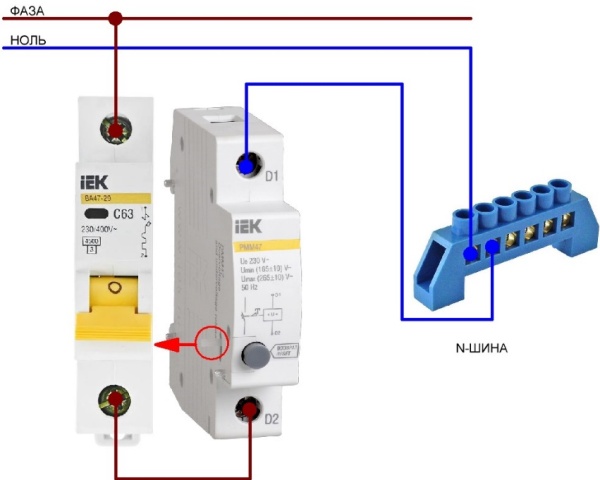Categories: Automata and RCD
Number of views: 3936
Comments on the article: 0
Additional devices for circuit breakers
In order to better and more accurately automate current protection, as well as to monitor the state of current protection of electrical equipment, in addition to circuit breakers, additional devices to them are useful. As such devices, block contacts, undervoltage releases and independent releases are used.
These devices are available today by many manufacturers. circuit breakers, which allows, in principle, to immediately get an automaton with advanced functionality, you just have to attach an auxiliary module to it.

Contact block
A contact block is a separate modular block, inside of which there is one or several contacts controlled mechanically from a circuit breaker installed in the vicinity. The contacts inside the block can be closing and / or opening.
Typically, these modules are designed for switching alternating current up to 6 amperes or direct current up to 1 ampere at a voltage of 230 and 250 volts, respectively, therefore the circuits in which the block contacts are installed must always be protected by current (at least fuses).

Typically, a block contact module is twice as wide as a standard circuit breaker, although it has a similar profile to it. The block contact is mounted to the left or right of the circuit breaker, close to it, using a special mount. Thus, at least one block contact can be connected to one circuit breaker.
Today, three types of block contacts are produced: position, actuation, and universal (capable of working, as selected by the user, as position block contacts or as actuation block contacts — the mode is set by a switch on the block contact housing).
Position contact block
The position contact blocks serve as peculiar switching means of indicating the current state of the circuit breaker. It is advisable to use this solution for the purpose of automated monitoring of the current position of the circuit breaker contacts: are the contacts of the circuit breaker closed or open at the moment?
This can be judged by the observed state of the internal contacts of the block contact. That is, it will reflect the real state of the circuit breaker, regardless of the reason why the machine is in one or another stable state.
When the contacts of the circuit breaker are closed, the contacts of the closing position contact block are closed at the same time, or if the contact block is open, its contacts are opened.

If the circuit breaker for some reason tripped (due to excess current, from the action of the undervoltage release or an independent trip, or as a result of a manual trip), then the contacts of the closing position contact block will immediately open, and if the block contact is open then shut up.
Thus, the position block contacts are applicable in the auxiliary signaling and monitoring circuits. For example, if a building has many circuit breakers installed on different floors, and it is necessary to monitor the switching state of all these switches from one place, then the solution with position block contacts is very convenient.
In addition, block contacts of this type themselves can control the supply of power to other devices in the system in which they work together with circuit breakers, or to devices from another system.
Contact Block
The operation contact contact is designed to indicate the fact of the operation of the circuit breaker precisely because too much current flows through the circuit protected by this switch.
When the contacts of the circuit breaker are closed, the contacts of the closing blocking contact of the operation go into the closed position, and in the opening - into the open position.
The contacts of the trip contact block will return to their original position either due to the circuit breaker opening the protected circuit due to overcurrent, or if the circuit breaker was opened using an undervoltage release or an independent release.

A distinctive feature of the tripping contact block is that when you turn off the circuit breaker manually, the contacts of the block contact will not change their position!
For this reason, the tripping contact blocks are used mainly in those auxiliary circuits where alarm is required to turn off the circuit breakers precisely because of exceeding the maximum permissible current in the circuit protected by one circuit breaker or another. In addition, the actuation block contact itself is capable, like the position contact block, of controlling the switching of other circuits.
Shunt release
The next representative of additional devices for circuit breakers is an independent release. This device itself is not controlled by an automatic machine; it is controlled by an external current source.
However, the independent release itself controls the machine, that is, it can serve to remotely control the state of the circuit breaker next to which it is installed.
As soon as a current is supplied to the control circuit of the shunt trip, the device mechanically acts on the corresponding node of the circuit breaker, which leads to the transition of the latter to the open state - the switch is in the "off" state.
The control signal for an independent trip can be triggered, for example, by pressing a button, using a relay or some electronic unit at the moment when some predetermined conditions have occurred, for example, by clock, timer, barometer, thermometer, etc. then return the circuit breaker to its original state, it will be necessary to cock it manually.

Typically, an independent release is controlled by an alternating voltage of 12 to 400 volts, or a constant voltage of 12 to 250 volts. The control circuit of the shunt trip must be protected by current (at least fuses), since the manufacturer limits this parameter.
The structurally independent trip unit is a modular unit of a width similar to the width of a single-pole circuit breaker, i.e. about 18 mm. Otherwise, the release profile is similar to the switch profile for the convenience of their joint installation and interaction.
The shunt trip is mounted on the side of the circuit breaker using a mount specifically provided by the manufacturer. Thus, at least one shunt trip can be attached to one circuit breaker, to which, in turn, one or more block contacts can be attached. The result is a remote control system for the circuit breaker with indication.
Undervoltage release
This auxiliary device, acting mechanically, causes the circuit breaker to open, provided that at the terminals of the trip unit (as its name implies) the voltage has dropped below the set voltage. Opening can be initiated immediately or with a time delay.
The main task of the undervoltage release is to control the shutdown of the circuit breaker and, accordingly, disconnect the equipment associated with it from the network if the voltage in this network has become unacceptably low for this equipment.
As a rule, the minimum voltage at which the release is activated is 0.75 of the nominal 230 volts, that is, about 173 volts.In addition, the release will prevent the machine from restarting if the voltage does not return to a value above 0.85 of the nominal, that is, while the voltage in the power supply of the equipment protected by the circuit breaker is at a level of less than 196 volts.

Typically, the undervoltage release is controlled by alternating current in the voltage range from 24 to 400 volts, or from 24 to 220 volts for constant voltage. Structurally, the trip unit is a module in width equal to the width of a standard single-pole switch, and is similar in shape to it.
This module is attached to the machine from one of its sides with the help of a machine specially provided by the manufacturer and a trip mechanism release. At least one block contact can be connected to the undervoltage release itself.

This type of trip can also have make or break contacts inside. These contacts are applicable for controlling the circuit breaker and for the purpose of interfacing the release with other control circuits.
Separate models of undervoltage releases provide the user with the possibility of a wide adjustment of the operating voltage, as well as adjusting the time delay for the operation.
The release can, if desired, be equipped with a button or opening contacts in its control circuit, then it will be able to work as an independent release. After the circuit breaker opens, undervoltage release, it will be necessary to re-cock it manually.
See also:
What are overvoltage and undervoltage releases and how are they used?
See also at i.electricianexp.com
:
